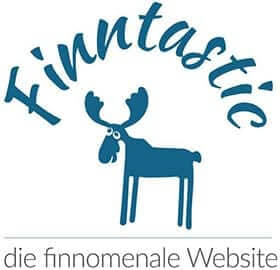Nowadays, Finland is well known for its great metal music. No other country has as many metal bands per capita as Finland. That’s why Finland is often called “the country of Heavy Metal”. But why are there so many good metal bands from Finland? And how has the Finnish metal scene changed over the years from its beginnings in the 80s up to the present day? I talked to journalist, communications expert and metalhead Maila-Kaarina Rantanen, who is one of the directors of the documentary “A Heavy Metal Civilization”.
Navigation:
- Interview with Maila-Kaarina Rantanen about the history of Finnish metal (English version)
- About the film „A heavy metal civilization“
- Interview (German version)
- Über den Film „A heavy metal civilization“ (German version)
The history of the heavy metal scene in Finland – Interview with Maila-Kaarina Rantanen, one of the directors of the documentary “A Heavy Metal Civilization”.
Finntastic:
Moikka Maila-Kaarina, nice to meet you. Cristina and you are both from Brazil. So, before we talk about your documentary “A Heavy Metal Civilization“, we would like to know: What is your connection to Finland?
Maila-Kaarina:
I am connected to Finland all my life. My father is Finnish, so I am half Finnish. I have a big family in Finland. My relatives are from Kouvola and I now live in Järvenpää, a town on Lake Tuusula not far from Helsinki. And Cristina moved here from Brazil, I think about ten years ago. She came to Finland as an au pair, but she already had experience as a photographer and journalist in Brazil. She got a job and stayed. I have been living in Finland for 14 years now, a little longer than Cristina and I also have a Master’s degree in Communication Management from Haaga Helia University of Applied Science in Helsinki.
Finntastic:
You and Cristina, you both like metal music. When did you first get in touch with metal music?
Maila-Kaarina:
I think it was at the age of eleven. I was listening to this Ozzy Osbournes song “Mr. Crowley” and I had piano lessons. This song had an organ intro and I thought: “Oh my God this is the most amazing thing I have ever heard in my life!” But I didn’t know at the time, that I was listening to metal music. I thought heavy metal was the name of the guy (laughs), but then a friend of mine, who owned the record said: “No, that’s not the name of the guy! Heavy Metal is the style of music!” And I said “Oh, Ok!” and then I started to listen to this music and it became my passion and also a kind of lifestyle.
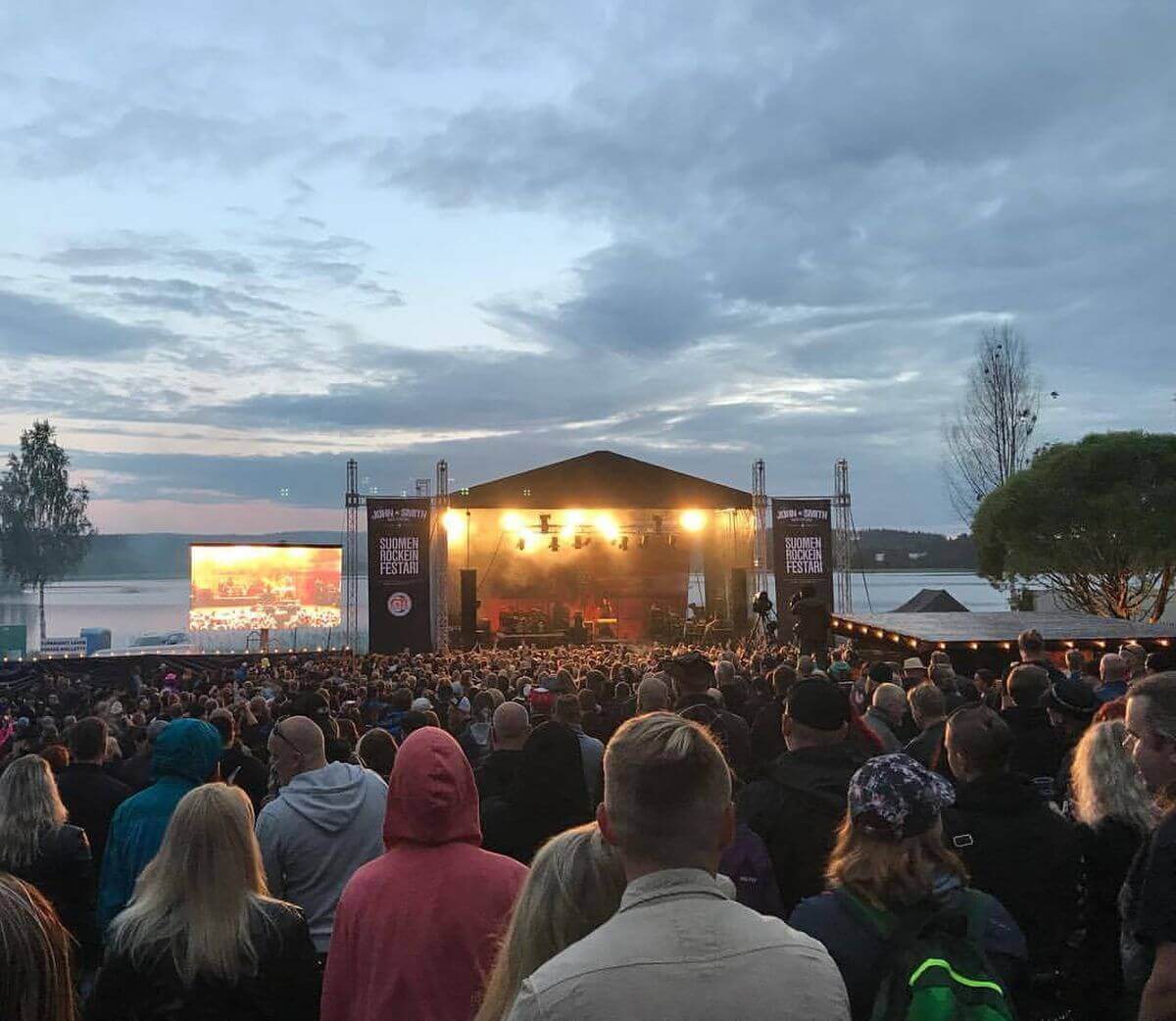
Finntastic:
What do you like about this music style and which are your favourite metal bands?
Maila-Kaarina:
What fascinates me about heavy metal is that I associate heavy metal with freedom, freedom of expression and power. The music is so strong and powerful. It moves and it motivates me. The question about my favourite bands is a little bit more tricky to answer. I love so many bands! But regarding Finland I would say, my favourite Finnish band of all time is “Children of Bodom”. I really love them. And I’am so sad, that they don’t exist anymore. I feel Alexi’s passing deep in my heart. I am also a big fan of Amorphis and Sentenced. And my favourite foreign metal band would be megadeath.
Finntastic:
How did you get the idea for your movie “A Heavy Metal Civilization“? When did you start working with Cristina? Do you know each other from Brazil?
Maila-Kaarina:
No, we both met through Facebook in a group called „Brazilians in Finland“. We discovered, that we had a lot of friends from Brazil in common and that we both like metal music. After we met, we decided to create a YouTube channel to talk about Heavy Metal and Finland. But unfortunately, this channel got so little visibility. So, we though: Let’s do something bigger. And Cristina is a big fan of this guy called Sam Dunn, who made these two documentaries „Metal: A Headbanger’s Journey“ and „Iron Maiden’s Flight 666“. After watching A Headbanger’s Journey, we thought: „Let’s do something related to Finland, something about the history of Heavy Metal in Finland. This was how the idea for our documentary was born.
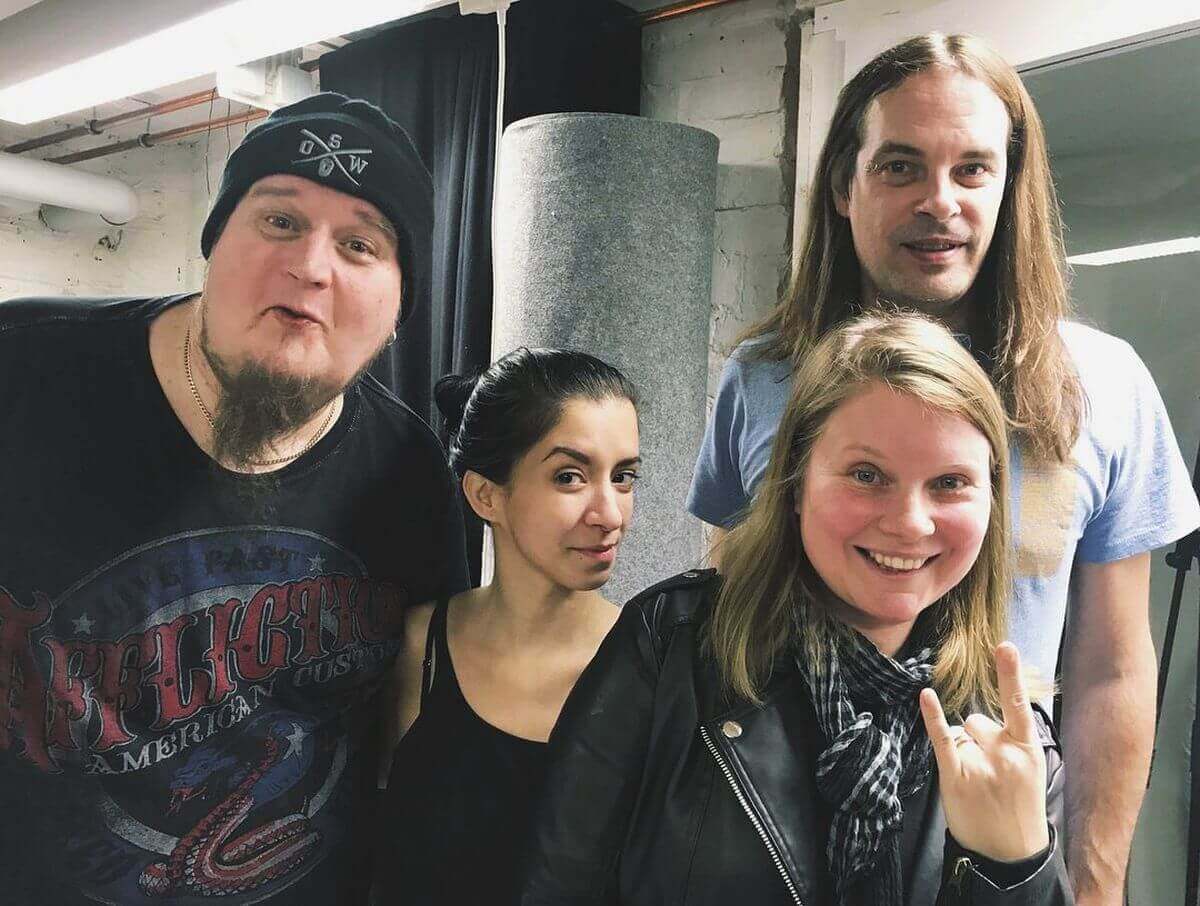
Finntastic:
And how did you choose the musicians for the documentary? Was it difficult to get in touch with them?
Maila-Kaarina:
I would say, that here in Finland the artists are all very open and also the people in the press agencies, who work with them. So it was not difficult to get in touch with the artists. First of all, we made a huge list of all bands and artist from every decade. And then we sent our project to the artists and press agencies, hoping that someone would respond. Henri Sorvali of Moonsorrow was the first to reply that he was interested in being part of the project.
Then we got a response from Kiko Loureiro, the guitarist of Megadeath. Other contacts were made through mutual friends. A friend of mine, who is a journalist at the Finnish broadcast company Yle asked Gas Lipstick of HIM, if he would like to take part. He said yes, so we got in touch with him. And with Marco Hietala we got in contact through the publisher of his book. And the contact to Niklas Etelävuori, the former bass player of Amorphis, now Flat Earth, also came through friends. Finally, we could start with the first interviews and when we mentioned that all these people were just involwed in the film, the other artists started to accept, because they understood that this film project had to be serious.
Finntastic:
How long did it take from the idea to the realization of the film?
Maila-Kaarina:
We started the project and the collaboration in 2016, and the documentary was finished in 2018. It took us two years to interview everyone. It has been a huge process. Because it wasn’t very easy to do these interviews, because the bands are always touring, so they don’t always have time to stop by and talk to you.
Finntastic:
Did you get any funding for the film?
Maila-Kaarina:
Not at all. We didn’t have any funding. We paid all the money we needed ourselves, including all the sound and camera equipment. For the post-production and sound editing, we were very lucky to have Bruno Leo Ribeiro, who was living in Finland at the time. The guy is a genius in art direction, award-winner and creator of the emojis from Finland, and he agreed to partner with us and take care of the post-production and audio. Bruno was our angel in this project.
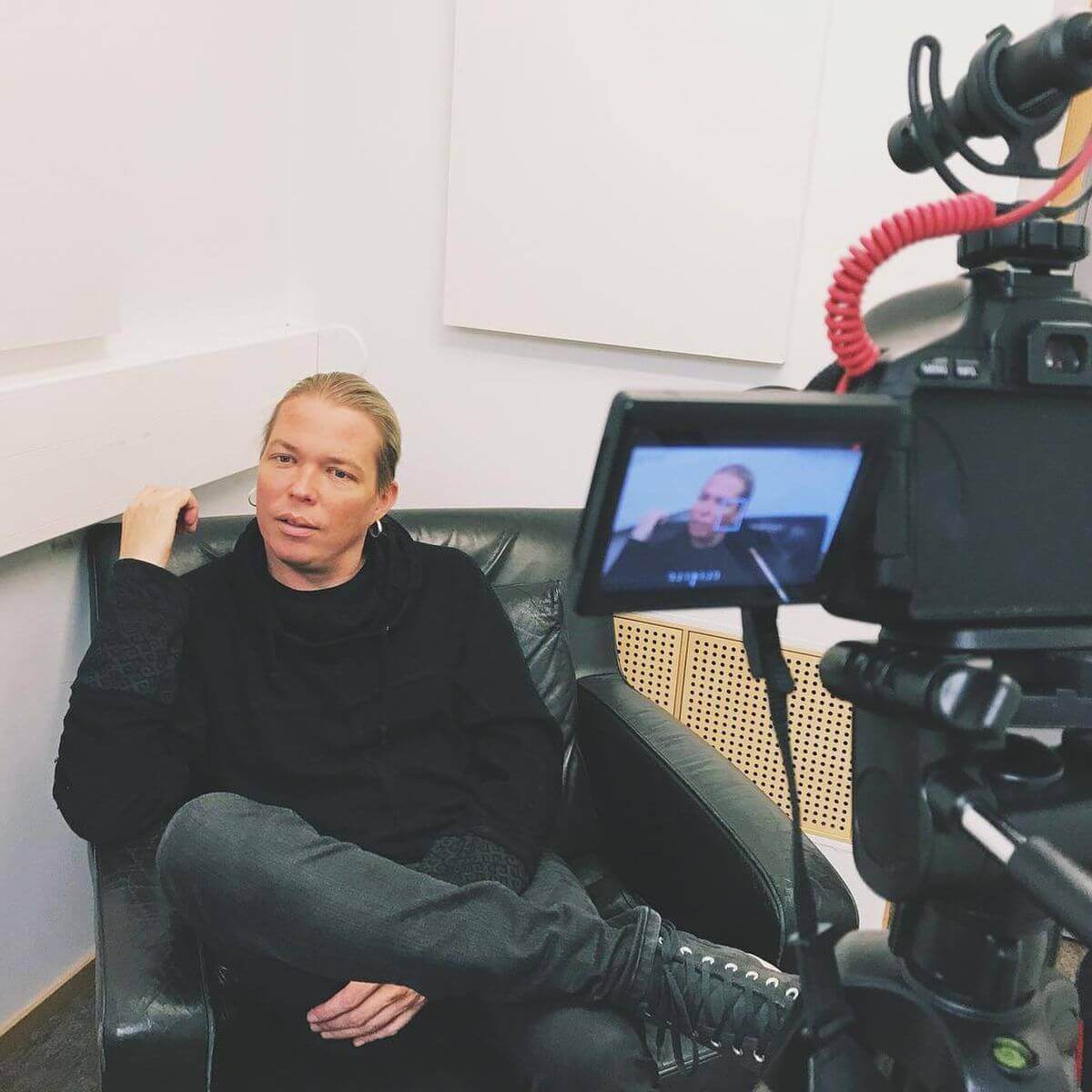
Finntastic:
I heard that the music journalist and owner of the website “Metal from Finland”, Tero Tolkki, also liked your documentary. Did he help you to realize the film?
Maila-Kaarina:
Unfortunately, I met Tero for the first time, after the film was finished. I would have loved to interview him, but we didn’t have the space to include him in the film. But Tero was still very important for us, because he was the first person, who really saw the film as a critic and expert on Finnish heavy metal. He gave us great feedback, which was very good!
Finntastic:
Tell us a bit more about your documentary
Maila-Kaarina:
Our idea was very simple: We wanted the artists to tell the story. That’s why we made it very journalistic. We prepared an interview script with questions, divided it into decades and themes: For example, we had questions about the 80s, 90s and the 2000s. We asked the same questions to pretty much everybody. And then we created the storyline based on those answers. This worked very well. Of course, the interview script changed a bit over time, because in two years we got some new information like some of the artists said something we hadn’t thought of before. And when we heard about it, we thought this is important and has to be in the film, so it starts to shape the film and the whole story of the film.
Finntastic:
That sounds very challenging.
Maila-Kaarina:
Oh yes, because we had to listen to 60 hours of interview recordings. I don’t really know, how it endet up (laughs). It was a bit like a puzzle. Unfortunately, there’s so much material, that we couldn’t include in the film. We could have made a documentary over an hour long, for sure, but we didn’t have a production company behind us. So the easiest way was to go to TV like Yle and to streaming platforms. We also wanted to show our film at festivals. We thought, it would be much easier for us to enter the festivals as an independent short film than as a full-length documentary film. That was another reason why we cut a lot. But in the end I think it was good that way.
Finntastic:
What would you say is the most popular metal genre at the moment and do you have a favourite?
Maila-Kaarina:
There is no metal genre that stands above everything in Finland at the moment. I think there are so many different bands, so many different styles. Sure, not everyone likes every style, but people go to the shows and festivals. They appreciate the music and respect the bands. I am a big fan of death metal and melodic death metal, which is quite popular in Finland at the moment. There is a Finnish band called “Where is my bible”. They are going to use some old Viking instruments on their new album. I think they are one of the best bands from Finland at the moment.
But as I just mentioned, there is also a huge boom of modern metal bands. Musicians who are still in their twenties and who mix a lot electronic and industrial stuff in their music. A lot of them have a grunge influence, for example and their music is more 90s style. I have no idea how many genres there are in Finland, but I think there is a lot of good stuff coming up.
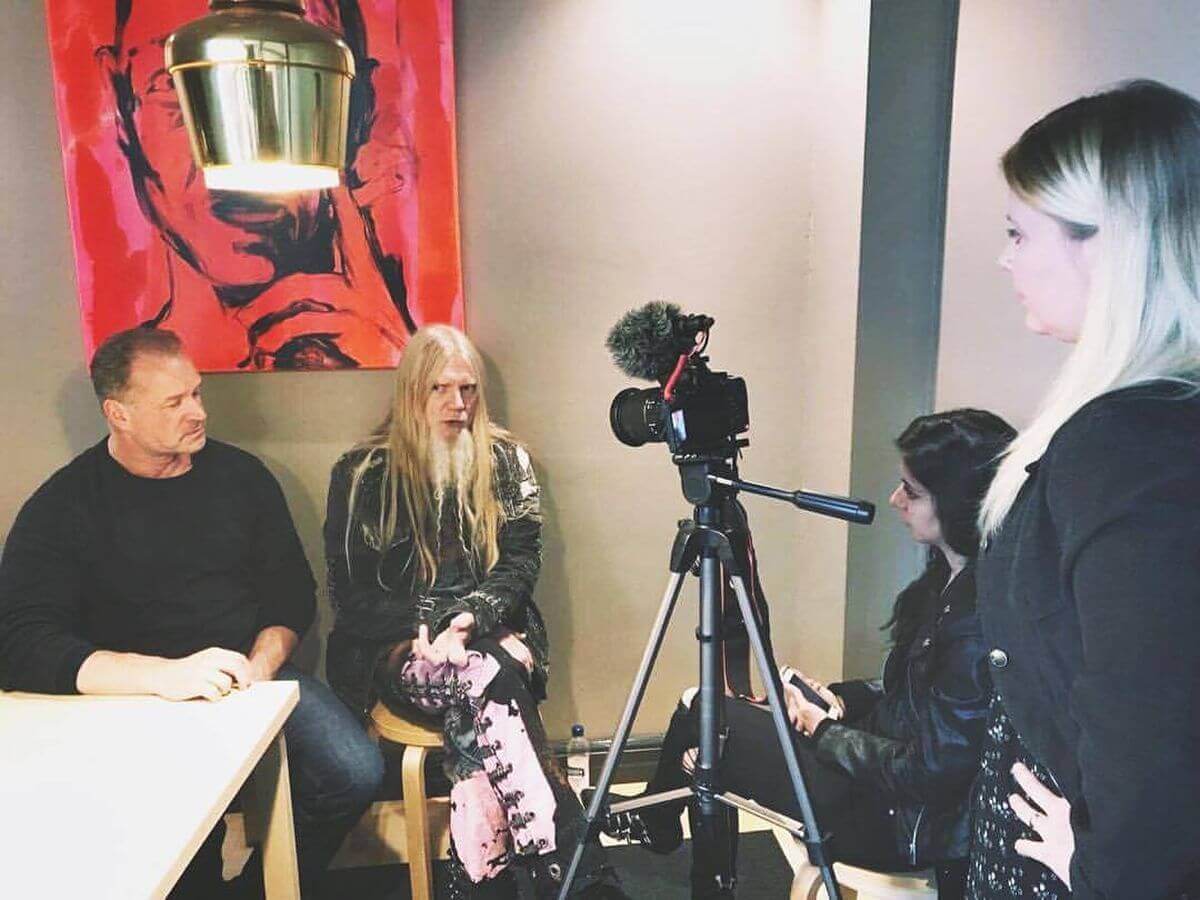
Finntastic:
How would you characterize the Finnish heavy metal scene of the 80s, compared to the Finnish metal scene of today?
Maila-Kaarina:
The Heavy Metal scene in the 80s was very different from today’s scene in that case that it was basically non-existent. Many bands from Finland didn’t even travel outside Finland and Europe. This changed after the mid-90s, when Stratovarius became famous in the USA and also in Latin America. In the first decade of 2000 other bands like Children of Bodom, Nightwish, Apocalyptica, Amorphis and HIM followed. It was the moment when people started to connect online. The internet started to be like big. And these bands came at a time, when borders were getting smaller.
Even we in Brazil, where grunge was much more popular than metal at that time, had that feeling: All the good metal stuff comes from Finland. But then after 2010 this metal wave started to go down again. A lot of bands wanted to sound like HIM, Stratovarius or Nightwish and metal lost its personality a bit. Heavy Metal started to become more mainstream. Luckily, Finnish metal is having a great time again. I don’t know, how famous Finnish metal bands are in Japan at the moment, for example, but I see Finnish metal bands of all styles touring everywhere: in the USA, in Latin America and also in Europe they play at all the big festivals. And there are still so many new Finnish metal bands coming up, so I think, the metal scene in Finland is richer than ever.
Finntastic:
So would you say that these Finnish metal bands could be seen as some kind of pioneers for the success of Finnish heavy metal?
Maila-Kaarina:
Yes, all these bands I mentioned before, but especially Stratovarius, which is the band that brought the name of Finnish metal outside Europe. There was also Tarot, which was one of the first metal bands from Finland, but they were not so famous abroad at that time. But of course they started to build up the heavy metal scene in Finland together with Stone. They were also important for the beginning of the metal scene in Finland, because they were the first metal bands, who started to play shows in Finland. But nowadays they are better known outside Finland. Tarot for example got more attention abroad because of the popularity of Marko Hietala and Nightwish.
Finntastic:
And what do you think is the secret of the worldwide success of Finnish metal bands?
Maila-Kaarina:
I would say that Finnish metal bands don’t want to be mediocre. They are quite perfectionists, which I think has a lot to do with being Finnish. So, the quality of Finnish metal music is always high. The other reason is that the bands take care of their identity. They are not just making music. They are very good at creating an image that can be promoted very well.
I also think, that the musical education from an early age is another reason for the success. And this professionalism and being so good at what you do has a lot to do with the support from an early age but also from the state. In Finland we have many support programs for artists. Some of them are for instruments, some for recording or graphic material. Some are even for renting a rehearsal room or even for touring. But I don’t think it’s so easy for bands and musicians to get these funds, because there’s a lot of competition in Finland. This competition makes it even harder for every new band to find their place. I think, that nowadays it is quite hard to be a metal band in Finland because of that.
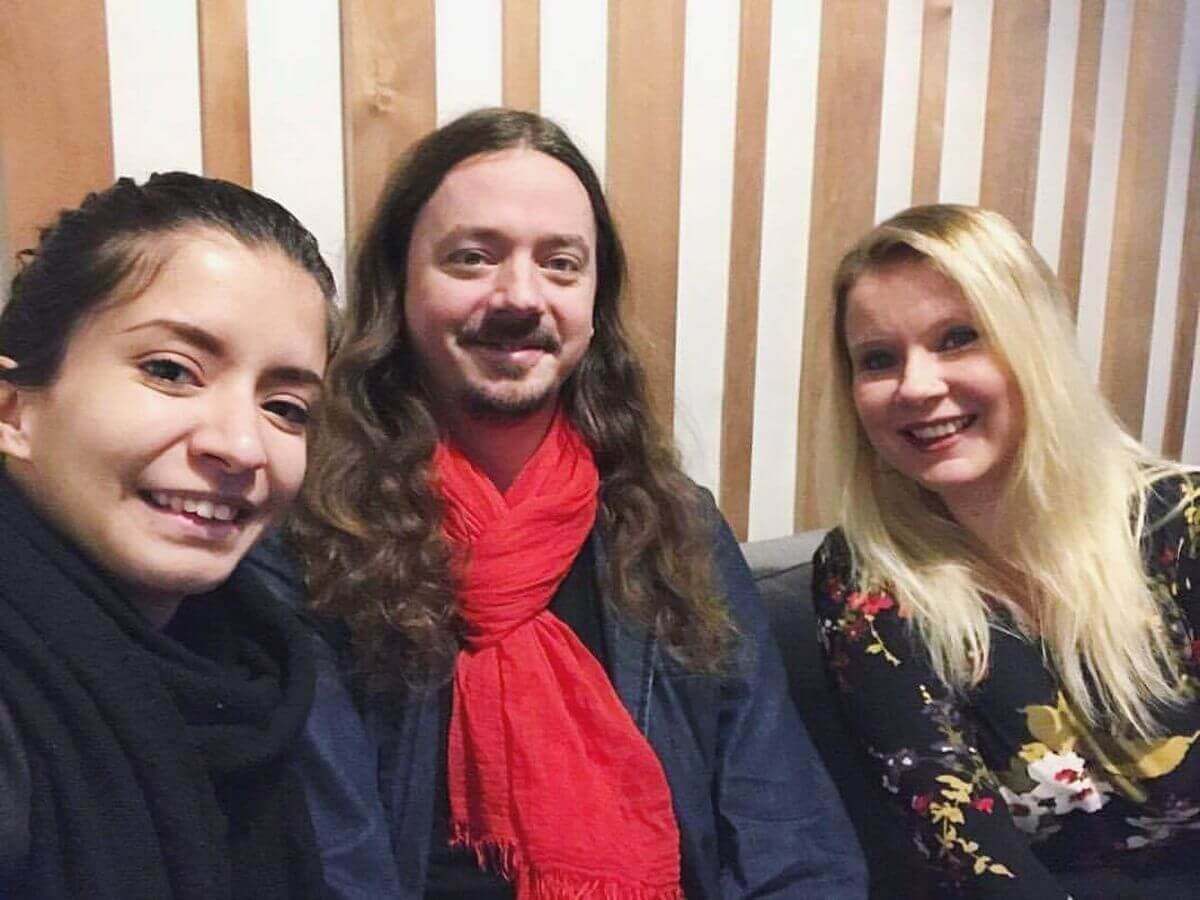
Finntastic:
And where do you think Finnish metal bands get their inspiration for their good music?
Maila-Kaarina:
Most of the people I asked said, that they don’t really know the answer, but they think that the darkness and the coldness helps a little bit. You tend to be more melancholic and you spend more time indoors, so it somehow helps you to be inspired to make more sad and powerful music.
Finntastic:
Some of the musicians in the documentary said that they don’t like metal becoming more mainstream. Do you agree with that?
Maila-Kaarina:
Yeah, I don’t like the idea of heavy metal going mainstream either. What makes us love metal is the power, the self-expression, the rebellion. It’s not good, if metal loses this image of Rock’n’Roll. But that was, what happened at the beginning of the 2000s. People didn’t know the bands. They bought the merch and said, they loved the music. They did the horns and all that stuff, but they even don’t know much about the meaning of heavy metal music. Luckily, things are better now. However, I don’t see so many young people listening to metal music anymore. I think metal is getting a bit “old”. In the 90s there were a lot of teenagers listening to metal. Now most of the metalheads are in their 30 or 40ties.
Finntastic:
And how do you think the metal scene in Finland will change in the next years?
Maila-Kaarina:
I don’t really know, but I think we’re not at that moment any more, when one style will somehow overcome all the others. I think there will always be new bands from all styles, which is great, because Heavy Metal needs to renew itself. As I said, we are getting old (laughs). Metal music of the new generation will be more mixed with industrial and electronic stuff, because the young generation is digital. But I really don’t know, if they will take over the scene.
Finntastic:
And how was it for you to meet such famous musicians in person?
Maila-Kaarina:
It was an honour for us. It means that we have done something great, because they believed in our idea and were willing to participate without charging anything. Everybody did it out of pure good will. It was great, whenever I think about it and those days when I met all those guys and talked to them.
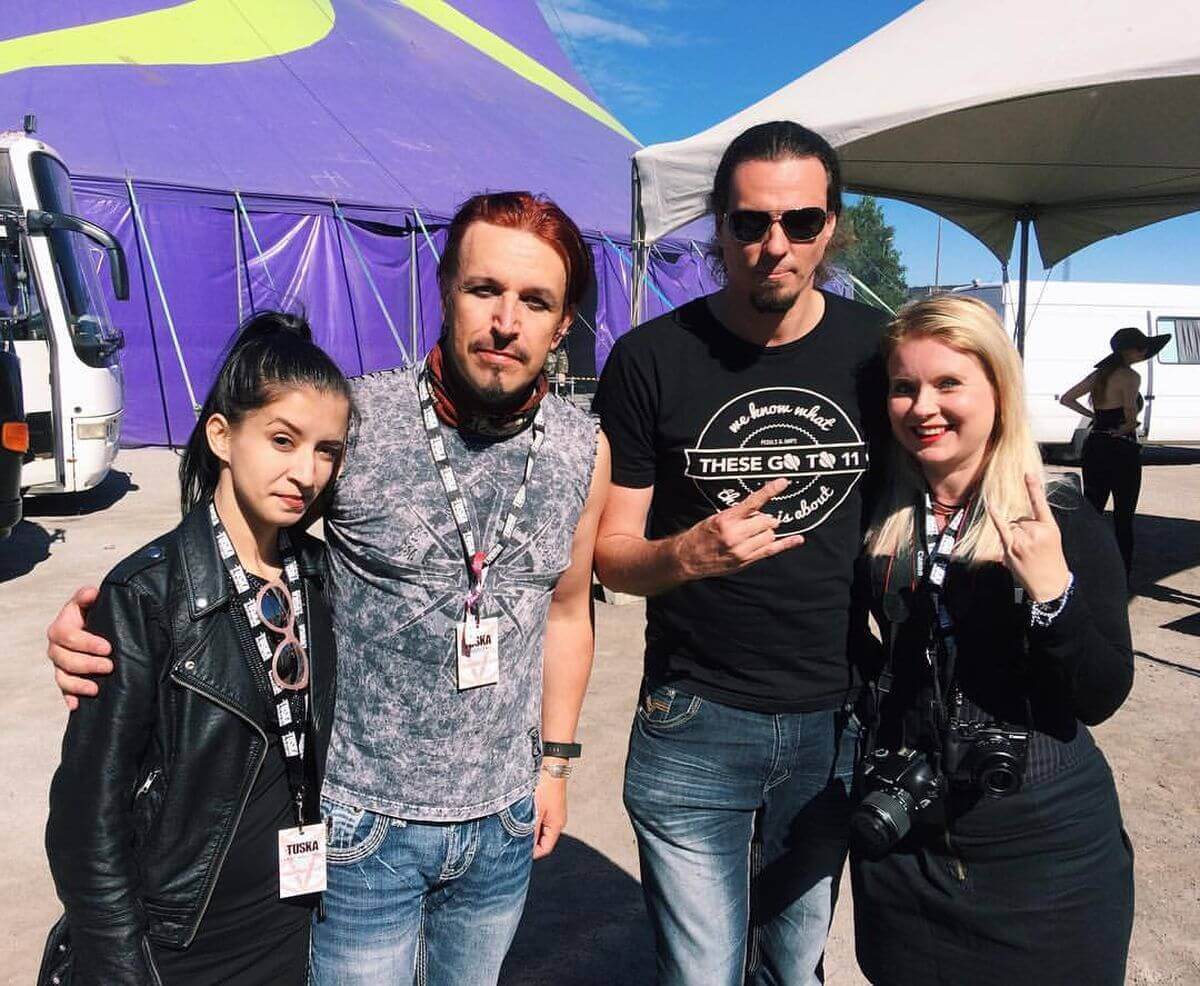
Finntastic:
Is there a metal musician you would have liked to interview for your movie, but unfortunately it didn’t work out?
Maila-Kaarina:
Well, we would have loved to interview Alexi Laiho or someone from Children of Bodom. That was the only band, where nobody ever answered to us. And another person we tried, but we didn’t get any answer from her management was Tarja Turunen. We also tried to get in contact with Ville Valo from HIM. But at that time the band had already split up and Ville Valo didn’t want to give interviews. These are the bands and the artists we wanted to interview for the film. Nowadays, I have some kind of special feelings for Children of Bodom, because the band doesn’t exist anymore, because Alexi Laiho died in 2020. But Alexi Laiho and all these artists are mentioned in the documentary, so they are still a part of the film.
Finntastic:
How is the feedback on your documentary so far? And where can we watch or buy your documentary “A Heavy Metal Civilization“, if we want to know more about the history of the Finnish heavy metal scene?
Maila-Kaarina:
The feedback has been very good, especially from abroad. Of course, there were some people, who commented on YouTube or Yle: “Oh, this band is missing or this is incomplete!” And some people didn’t like the name “A Heavy Metal Civilization”, because they think it’s a bit arrogant. But it’s impossible to please everybody. But in general the feedback has been very positive. Our documentary is now available for everyone to see on YouTube. Before that, it was shown on Yle’s streaming platform for a year, which was great. Finland is such a small country, but we had 50.000 people watching our film there! And of course, we are super open to anyone, who wants to screen our documentary on platforms or show it at film festivals. Just contact us by mail, if your are interested.
Finntastic:
What are your plans for the future? Do you already have a new film planned? Will it be about Heavy Metal again?
Maila-Kaarina:
We don’t have any plans for anything new at the moment. This project cost us a lot of energy. We had no idea how hard it would be to break into this movie scene, when you are not from the film industry or have any references. But never say never! Maybe in a few years we have a great idea and we will do something new together.
Finntastic:
That sounds great. Thank you for your time!
Maila-Kaarina:
It was a pleasure for me as well to talk to you about the film and heavy metal music. Maybe next time we will meet at some Finnish metal festival.
About the film “A heavy metal civilization”
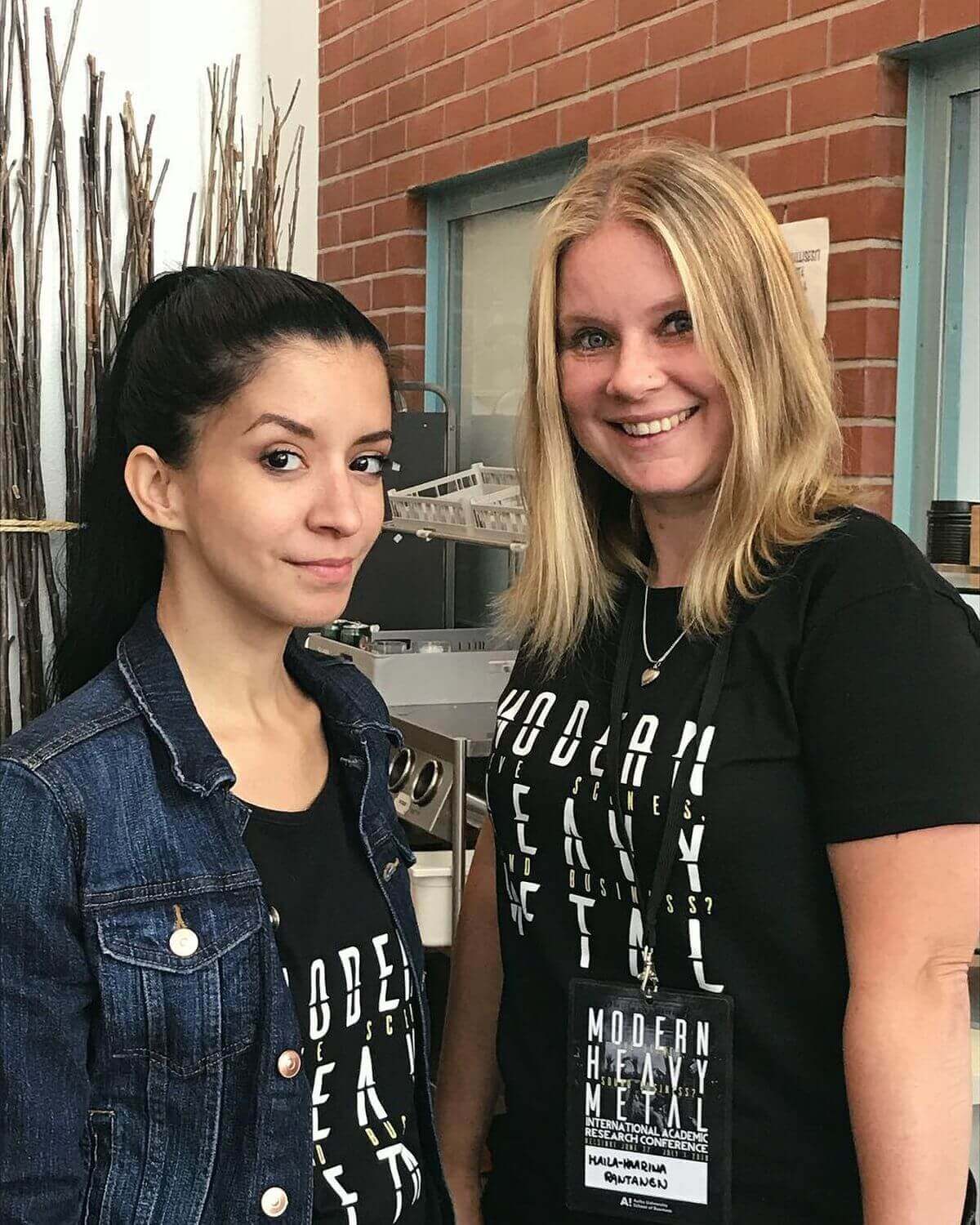
“A heavy metal civilization” is a documentary film made by journalist and communication specialist Maila-Kaarina Rantanen and journalist and photographer Cristina Ornellas. It tells the history of the Finnish metal scene from its beginnings to the present through interviews with the most famous and representative Finnish musicians of the Finnish metal scene and industry (e.g., Marco Hietala (former singer and bassist of Nightwish, now Tarot), Gas Lipstick (former drummer of HIM, now Flat Earth), Lauri Porra (Stratovarius), Eicca Toppinen (Apocalyptica) and many more.
Notice: Finntastic.de uses WP YouTube Lyte to embed YouTube videos GDPR compliant. If you click the "Play"-Button YouTube will collect information about you!
(VIDEO: Maila Kaarina Rantanen, Cristina Ornellas/A Heavy Metal Civilization) If you are interested in Finnish metal music, check out the documentary „A Heavy Metal Civilization“ by Maila-Kaarina Rantanen and Cristina Ornellas on YouTube!
More information about the documentary can be found on Facebook. You can stream the whole documentary on YouTube. If you are interested in screening the film at your festival or streaming platform, get in touch with Maila-Kaarina Rantanen by mail.
Deutsche Version
A Heavy Metal Civilization – Ein Dokumentarfilm über die Geschichte des finnischen Metal
Finnland ist bekannt für seine großartige Metalmusik. In keinem anderen Land gibt es so viele Metal-Bands pro Kopf der Bevölkerung wie in Finnland, weshalb das Land auch als „das Land des Heavy Metal“ bezeichnet wird. Aber warum kommen so viele gute Metalbands aus Finnland? Und wie hat sich die finnische Metalszene im Laufe der Jahre seit ihren Anfängen in den 80er Jahren bis in die Gegenwart verändert? Ich habe mit Journalistin, Kommunikationsexpertin und Metalhead Maila-Kaarina Rantanen gesprochen. Sie ist eine der Regisseurinnen des Dokumentarfilms „A Heavy Metal Civilization“.
Die Geschichte der Heavy-Metal-Szene in Finnland – Interview mit Maila-Kaarina Rantanen, einer der Regisseurinnen des Dokumentarfilms „A Heavy Metal Civilization“.
Finntastic:
Moikka Maila-Kaarina, schön, Dich kennenzulernen. Cristina und Du, ihr stammt beide aus Brasilien. Bevor wir über euren Dokumentarfilm „A Heavy Metal Civilization“ sprechen, wollen wir unbedingt mehr über eure Verbindung zu Finnland wissen.
Maila-Kaarina:
Ich bin schon mein ganzes Leben lang mit Finnland verbunden. Mein Vater ist Finne. Ich bin Halbfinnin und habe daher eine große Familie in Finnland. Meine Verwandten kommen aus Kouvola und ich lebe jetzt in Järvenpää, einer Stadt am Tuusula-See, nicht weit entfernt von Helsinki. Cristina ist auch aus Brasilien nach Finnland gezogen, ich glaube vor zehn Jahren. Sie kam damals als Au-pair nach Finnland, hatte aber in Brasilien bereits Berufserfahrung als Fotografin und Journalistin gesammelt. Sie hat hier einen Job bekommen und ist geblieben. Ich lebe jetzt seit 14 Jahren in Finnland, ein bisschen länger als Cristina, und ich habe meinen Master in Kommunikationsmanagement an der Haaga Helia University of Applied Science in Helsinki gemacht.
Finntastic:
Du und Cristina, ihr mögt beide Metal. Wann bist Du das erste Mal mit Metalmusik in Berührung gekommen?
Maila-Kaarina:
Ich glaube, das war im Alter von elf Jahren. Ich hörte diesen Ozzy Osbournes Song „Mr. Crowley“ und ich nahm Klavierunterricht. Dieser Song hatte ein Orgelintro und ich dachte: „Oh mein Gott, das ist das Tollste, was ich je in meinem Leben gehört habe!“
Zu diesem Zeitpunkt wusste ich aber noch nicht, dass ich gerade Metalmusik höre. Ich dachte, Heavy Metal sei der Name des Typen (lacht), doch dann sagte der Freund, der die Platte besaß zu mir: „Nein, das ist nicht der Name des Kerls! Heavy Metal ist der Musikstil!“ Ich sagte: „Oh, OK!“, und dann begann ich, mir diese Musik anzuhören und sie wurde letztendlich zu meiner Leidenschaft und auch zu einer Art Lebensstil.
Finntastic:
Was gefällt dir an dieser Musikrichtung und welche sind deine Lieblings-Metal-Bands?
Maila-Kaarina:
Was mich an Heavy Metal fasziniert, ist, dass ich damit Freiheit, Ausdrucksfreiheit und Power verbinde. Die Musik ist so stark und kraftvoll. Sie bewegt und motiviert mich. Die Frage nach meinen Lieblingsbands ist hingegen etwas schwieriger zu beantworten. Ich liebe so viele Bands. Aber was Finnland betrifft, würde ich sagen, dass meine finnische Lieblingsband aller Zeiten „Children of Bodom“ ist. Ich liebe ihre Songs und ich bin so traurig, dass es sie nicht mehr gibt. Alexi Laihos Tod ist für mich bis heute sehr schmerzhaft . Ansonsten bin ich auch ein großer Fan von Amorphis und Sentenced und meine Lieblings-Metalband außerhalb Finnlands ist Megadeath.
Finntastic:
Wie seid ihr auf die Idee zu eurem Film „A Heavy Metal Civilization“ gekommen? Wann hat die Zusammenarbeit mit Cristina begonnen? Kennt ihr euch aus Brasilien?
Maila-Kaarina:
Nein, wir haben uns über die Facebook-Gruppe „Brasilianer in Finnland“ kennen gelernt. Wir fanden heraus, dass wir viele gemeinsame Freunde aus Brasilien haben und dass wir beide gerne Metalmusik hören. Nach unserem persönlichen Kennenlernen entstand die Idee einen YouTube-Kanal zu starten, um über Heavy Metal und Finnland zu sprechen. Aber leider bekam der Kanal kaum Traffic. Also dachten wir, wir müssen etwas Größeres machen. Cristina ist zudem ein großer Fan von Sam Dunn, dem Regisseur von „Metal: A Headbanger’s Journey“ und der Iron-Maiden Doku „Iron Maiden’s Flight 666“. Nachdem wir „A Headbanger’s Journey“ gesehen haben, dachten wir: „Wir machen etwas Ähnliches in Bezug zu Finnland und zwar eine Doku über die Geschichte des finnischen Heavy Metal.
Finntastic:
Und wie habt ihr die Musiker für den Dokumentarfilm ausgewählt? War es schwierig, mit ihnen in Kontakt zu kommen?
Maila-Kaarina:
Ich würde sagen, die Künstler hier in Finnland sind alle sehr offen, ebenso die Leute in den Presseagenturen, die mit ihnen arbeiten. Es war daher nicht schwer, mit den Musikern in Kontakt zu kommen. Als erstes haben wir eine riesige Liste mit allen möglichen Bands und Künstlern aus allen Jahrzehnten erstellt. Danach haben wir unsere Projektidee an die Künstler und Presseagenturen geschickt, in der Hoffnung, dass sich jemand meldet. Henri Sorvali von Moonsorrow war der erste, der uns antwortete und mitmachen wollte.
Dann bekamen wir eine Antwort von Kiko Loureiro, dem Gitarristen von Megadeath. Andere Kontakte kamen durch gemeinsame Freunde zustande. Ein Freund von mir, der Journalist beim finnischen Fernsehsenders Yle ist, fragte Gas Lipstick von HIM, ob er mitmachen wolle. Gas war einverstanden, also haben wir ihn kontaktiert. Und mit Marco Hietala sind wir über den Verlag seines Buches in Kontakt getreten. Und der Kontakt zu Niklas Etelävuori, dem ehemaligen Bassisten von Amorphis, jetzt Flat Earth, kam auch über Freunde zustande. Schließlich konnten wir mit den ersten Interviews beginnen. Und als wir erwähnten, dass all diese Künstler bereits an diesem Filmprojekt beteiligt waren, wollten weitere Künstler mitmachen, denn sie verstanden, dass dieses Filmprojekt ernst gemeint sein muss.
Finntastic:
Wie lange hat es von der Idee bis zur Realisierung des Films gedauert?
Maila-Kaarina:
Wir haben das Projekt und die Zusammenarbeit 2016 begonnen, der Dokumentarfilm wurde 2018 fertiggestellt. Wir haben zwei Jahre gebraucht, um alle zu interviewen. Es war ein langer Prozess, denn es war nicht einfach, die Interviews zu führen, weil die Bands ständig auf Tour sind und somit nicht immer Zeit hatten mit uns zu sprechen.
Finntastic:
Habt ihr eine Finanzierung für den Film erhalten?
Maila-Kaarina:
Nein, überhaupt nicht. Wir haben alles, was wir an Ausrüstung brauchten, selbst bezahlt, einschließlich der gesamten Ton- und Kameraausrüstung. Für die Postproduktion und den Ton hatten wir das große Glück, Bruno Leo Ribeiro an Bord zu holen, der damals in Finnland lebte. Der Mann ist ein Genie in Sachen Regie. Er ist mehrfacher Preisträger und auch Schöpfer der finnischen Emojis. Er erklärte sich bereit, mit uns zusammenzuarbeiten und sich um die Postproduktion und den Ton zu kümmern. Bruno war unser Engel bei diesem Projekt.
Finntastic:
Ich habe gehört, dass auch der Musikjournalist und Betreiber der Website „Metal from Finland“, Tero Tolkki, von eurem Dokumentarfilm begeistert war. Hat er euch bei der Realisierung des Films geholfen?
Maila-Kaarina:
Leider habe ich Tero erst kennengelernt, nachdem der Film schon fertig war. Ich hätte ihn gerne interviewt, aber wir hatten keine Möglichkeit mehr, ihn in den Film einzubinden. Trotzdem war Tero sehr wichtig für uns, denn er war die erste Person, die den Film aus der Perspektive eines Kritikers und Experten für finnischen Heavy Metal gesehen hat. Er hat uns großartiges Feedback gegeben, was sehr wichtig war.
Finntastic:
Erzähl uns ein wenig mehr über euren Dokumentarfilm.
Maila-Kaarina:
Gerne! Unsere Idee war eigentlich ganz einfach: Wir wollten, dass die Künstler die Geschichte erzählen. Deshalb haben wir alles sehr journalistisch aufgezogen. Wir haben ein Interviewskript mit Fragen vorbereitet, die nach Jahrzehnten und Themen geordnet waren: Wir hatten zum Beispiel Fragen zu den 80ern, 90ern und den 2000er-Jahren. Wir haben fast allen Musikern die gleichen Fragen gestellt. Aus Antworten haben wir dann die Storyline entwickelt. Das hat sehr gut funktioniert. Natürlich haben sich die Fragen im Laufe der Zeit ein wenig geändert, weil wir in zwei Jahren immer mehr neue Informationen erhalten haben, z. B. haben einige Künstler neue Dinge erzählt. Und als wir davon hörten, dachten wir, das ist ebenfalls wichtig und muss im Film vorkommen, und so begann sich, der Film und die Geschichte zu formen.
Finntastic:
Das klingt sehr herausfordernd.
Maila-Kaarina:
Oh ja, wir mussten uns 60 Stunden Interviewmaterial anhören. Ich weiß gar nicht so recht, wie wir das geschafft haben (lacht). Es war ein bisschen wie ein Puzzle. Leider gab es so viel Material, dass wir nicht alles in den Film einbinden konnten. Wir hätten ohne Probleme einen mehr als einstündigen Dokumentarfilm machen können, aber wir hatten keine Produktionsfirma im Rücken. Der einfachste Weg war also, an Fernsehsender wie Yle heranzutreten und unseren Film auf weiteren Streaming-Plattformen zu platzieren. Außerdem wollten wir unseren Film auf Festivals zeigen. Wir dachten, dass wir es als unabhängiger Kurzfilm viel einfacher hätten, auf Festivals gezeigt zu werden, als ein abendfüllender Dokumentarfilm. Das war ein weiterer Grund, warum wir viel gekürzt haben. Somit war es am Ende glaube ich, gut so.
Finntastic:
Was würdest du sagen, ist derzeit das beliebteste Metal-Genre und hast du einen Favoriten?
Maila-Kaarina:
In Finnland gibt es derzeit kein Metal-Genre, das über allem steht. Ich denke, es gibt so viele verschiedene Bands, so viele verschiedene Stile. Sicher, nicht jeder mag jeden Stil, aber die Leute gehen zu den Shows und Festivals. Sie schätzen die Musik und respektieren die Bands. Ich bin ein großer Fan von Death Metal und Melodic Death Metal, der in Finnland gerade sehr beliebt ist. Es gibt eine finnische Band namens „Where is my bible“, die auf ihrem neuen Album einige alte Wikinger-Instrumente verwenden. Meiner Meinung nach sind sie eine der besten finnischen Bands, die es derzeit in Finnland gibt.
Aber wie gerade erwähnt, gibt es auch einen riesigen Boom an modernen Metal-Bands. Musiker, die noch in ihren Zwanzigern sind, und die viel elektronische Musik und Industrial in ihre Musik mischen. Viele von ihnen haben zum Beispiel auch einen Grunge-Einfluss und ihre Musik erinnert mehr an den Stil der 90er-Jahre. Ich habe keine Ahnung, wie viele Genres es aktuell in Finnland gibt, aber ich glaube, es wird in nächster Zeit eine Menge neue, gute Musik geben.
Finntastic:
Wie würdest du die finnische Heavy-Metal-Szene der 80er-Jahre im Vergleich zur finnischen Metalszene von heute charakterisieren?
Maila-Kaarina:
Die Heavy-Metal-Szene in den 80er Jahren unterschied sich insofern von der heutigen Szene, als dass sie praktisch nicht existierte. Viele Bands aus Finnland waren nicht einmal außerhalb Finnlands und Europas unterwegs. Das änderte sich ab Mitte der 90er-Jahre, als Stratovarius in den USA und auch in Lateinamerika berühmt wurde. Anfang der 2000er-Jahre folgten weitere Bands wie Children of Bodom, Nightwish, Apocalyptica, Amorphis und HIM. Es war der Moment, als die Leute begannen, sich online zu vernetzen. Das Internet fing an, groß zu werden. Diese Bands kamen also zu einer Zeit, in der die Grenzen immer kleiner wurden.
Sogar wir in Brasilien, wo Grunge zu dieser Zeit viel populärer war als Metal, hatten dieses Gefühl: All die gute Metalmusik kommt aus Finnland. Aber dann, nach 2010, begann diese Metal-Welle wieder abzuflauen. Viele Bands wollten wie HIM, Stratovarius oder Nightwish klingen, und Heavy Metal verlor ein wenig seine Persönlichkeit. Metal wurde immer mehr „Mainstream“. Zum Glück erlebt der finnische Metal derzeit wieder eine gute Zeit. Ich weiß nicht, wie berühmt finnische Metalbands zum Beispiel gerade in Japan sind, aber ich sehe finnische Metalbands aller Stilrichtungen überall auf Tournee: Sie spielen in den USA, in Lateinamerika und auch in Europa auf allen großen Festivals. Und es gibt immer wieder neue finnische Metalbands, ich denke daher, die Metalszene in Finnland ist reicher und vielfältiger als je zuvor.
Finntastic:
Würden Du also sagen, dass diese finnischen Metal-Bands als Pioniere für den Erfolg des finnischen Heavy Metal angesehen werden können?
Maila-Kaarina:
Ja, all die Bands, die ich schon erwähnt habe, aber ich würde sage, es war vor allem Stratovarius, die den Namen des finnischen Metals außerhalb Europas bekannt gemacht hat. Es gab auch Tarot, die eine der ersten Metal-Bands aus Finnland war, aber sie war damals im Ausland noch nicht so bekannt. Aber natürlich haben sie zusammen mit Stone, die Heavy-Metal-Szene in Finnland entscheidend mitgeprägt. Vor allem waren sie Pioniere der Metalszene in Finnland, denn sie gehörten zu den ersten Metalbands, die in Finnland auftraten. Heute ist Tarot auch außerhalb Finnlands besser bekannt. An Aufmerksamkeit im Ausland haben sie vor allem auch durch die Popularität von Marko Hietala und Nightwish gewonnen.
Finntastic:
Und was ist Deiner Meinung nach das Geheimnis des weltweiten Erfolgs finnischer Metalbands?
Maila-Kaarina:
Ich würde sagen, dass finnische Metalbands nicht mittelmäßig sein wollen. Sie sind ziemliche Perfektionisten, und ich glaube, das hat viel damit zu tun, dass sie Finnen sind. Die Qualität der finnischen Metalmusik ist also immer hoch. Der andere Grund ist, dass die Bands auf ihre Identität achten. Sie machen nicht nur Musik. Sie sind sehr gut darin, ein Image zu schaffen, das sich sehr gut vermarkten lässt.
Ich denke auch, dass die musikalische Ausbildung von Kindesbeinen an ein weiterer Grund für den Erfolg ist. Und diese Professionalität und die Tatsache, dass man so gut ist in dem, was man tut, hat viel mit der Unterstützung von klein auf zu tun, aber auch mit der Unterstützung durch den Staat. In Finnland haben wir viele Förderprogramme für Künstler. Einige von ihnen sind für Instrumente, andere für Aufnahmen oder grafisches Material. Einige sind sogar für die Miete eines Proberaums oder sogar für Tourneen gedacht. Aber ich glaube nicht, dass es für Bands und Musiker so einfach ist, diese Gelder zu bekommen, weil es in Finnland viel Konkurrenz gibt. Dieser Wettbewerb macht es für jede neue Band noch schwieriger, ihren Platz zu finden. Ich denke, dass es aus diesem Grund für Metal-Band in Finnland recht schwer ist, sichtbar zu werden.
Finntastic:
Und woher, glaubst du, nehmen finnische Metalbands die Inspiration für ihre gute Musik?
Maila-Kaarina:
Die meisten Leute, die ich gefragt habe, sagten, dass sie die Antwort nicht wirklich kennen, aber sie denken, dass die Dunkelheit und die Kälte ein Grund sind. Man neigt dazu, melancholischer zu sein und man verbringt mehr Zeit in geschlossenen Räumen und das inspiriert einen irgendwie dazu, traurige und kraftvolle Musik zu komponieren.
Finntastic:
Einige der Musiker sagten im Dokumentarfilm, dass sie es nicht gut finden, dass Metal immer mehr Mainstream wird. Siehst Du das genauso?
Maila-Kaarina:
Ja, ich mag es auch nicht, dass Heavy Metal immer mehr Mainstream wird. Was wir an Metal lieben, ist die Kraft, der Selbstausdruck, die Rebellion. Es ist nicht gut, wenn Metal sein Rock and Roll-Image verliert. Aber genau das passierte Anfang der 2000er. Die Leute kannten die Bands nicht. Sie kauften die Fan-Artikel und sagten, sie lieben die Musik. Sie posierten just for Fun mit den Hörnern, aber sie wussten überhaupt nichts über die Bedeutung von Heavy Metalmusik. Zum Glück ist das jetzt nicht mehr so. Allerdings hören nicht mehr so viele junge Leute Metalmusik. Ich denke, Metal wird ein bisschen „alt“. In den 90erJahren gab es viele Teenager, die Metal gehört haben. Jetzt sind die meisten Metalheads in ihren Dreißigern und Vierzigern.
Finntastic:
Und wie wird sich die Metal-Szene in Finnland Deiner Meinung nach in den nächsten Jahren verändern?
Maila-Kaarina:
Keine Ahnung, aber ich denke, wir sind nicht mehr an dem Punkt, wo eine Stilrichtung alle anderen übertrumpft. Ich denke, es wird immer neue Bands aus allen Stilrichtungen geben, was großartig ist, denn Heavy Metal muss sich erneuern. Wie ich schon sagte, wir werden alt (lacht). Die Metalmusik der neuen Generation wird mehr mit Industrial und elektronischer Musik kombiniert werden, weil die junge Generation eben digital ist. Aber ob sich das in der Metal-Szene durchsetzt, weiß ich nicht.
Finntastic:
Und wie war es für euch, so berühmte Musiker persönlich zu treffen?
Maila-Kaarina:
Es war eine Ehre für uns. Es bedeutet, dass wir etwas Großartiges geleistet haben, weil sie an unsere Idee geglaubt haben und bereit waren, sich zu beteiligen, ohne etwas zu verlangen. Alle haben es aus reinem guten Willen getan. Es war großartig, wenn ich daran zurückdenke und an die Tage, an denen ich all diese berühmten Musiker traf und mit ihnen sprach.
Finntastic:
Gibt es einen Metalmusiker, den ihr gerne für euren Film interviewt hättet, aber wo es leider nicht geklappt hat?
Maila-Kaarina:
Nun, wir hätten gerne Alexi Laiho oder jemanden von Children of Bodom interviewt. Das war die einzige Band, von der wir nie eine Antwort bekommen haben. Und eine andere Person, die wir gerne interviewt hätten, aber leider keine Antwort von ihrem Management erhalten haben, ist Tarja Turunen. Wir haben auch versucht, mit Ville Valo von HIM in Kontakt zu treten. Aber zu dieser Zeit hatte sich die Band bereits aufgelöst und Ville Valo wollte keine Interviews geben. Das sind die Bands und die Künstler, die wir gerne für den Film interviewt hätten. Heute habe ich tiefe Gefühle für Children of Bodom, denn die Band gibt es nicht mehr, weil Alexi Laiho 2020 gestorben ist. Aber Alexi Laiho und all diese Künstler werden im Dokumentarfilm erwähnt. Sie sind also trotzdem Teil des Films.
Finntastic:
Wie ist die bisherige Resonanz auf euren Dokumentarfilm? Und wo kann man euren Dokumentarfilm „A Heavy Metal Civilization“ sehen oder kaufen, wenn man mehr über die Geschichte der finnischen Heavy-Metal-Szene erfahren möchte?
Maila-Kaarina:
Das Feedback war sehr gut, vor allem aus dem Ausland. Natürlich gab es einige Leute, die auf YouTube oder Yle kommentiert haben: „Oh, diese Band fehlt oder das ist unvollständig!“ Einige Leute mochten auch den Namen „A Heavy Metal Civilization“ nicht, weil sie ihn für ein bisschen arrogant hielten. Aber es ist unmöglich, es allen recht zu machen. Im Allgemeinen war das Feedback aber sehr positiv. Unser Dokumentarfilm ist jetzt für alle auf YouTube verfügbar. Davor war er ein Jahr lang auf der Streaming-Plattform von Yle zu sehen, was großartig war. Finnland ist so ein kleines Land, aber 50.000 Menschen haben sich dort unseren Film angesehen! Und natürlich sind wir super offen für jeden, der unseren Dokumentarfilm auf Plattformen streamen oder auf Filmfestivals zeigen möchte. Kontaktiert uns einfach per Mail, wenn ihr Interesse habt.
Finntastic:
Was sind Ihre Pläne für die Zukunft? Habt ihr schon einen neuen Film geplant? Wird es wieder um Heavy Metal gehen?
Maila-Kaarina:
Im Moment haben wir keine Pläne für etwas Neues. Dieses Projekt hat uns sehr viel Energie gekostet. Wir hatten keine Ahnung, wie schwer es sein würde, in dieser Filmszene Fuß zu fassen, wenn man nicht aus der Filmbranche kommt und keine entsprechenden Referenzen hat. Aber sag niemals nie! Vielleicht kommt uns in ein paar Jahren eine tolle Idee und wir machen etwas Neues zusammen.
Finntastic:
Das klingt großartig. Vielen Dank, dass Du Dir Zeit für ein Interview genommen hast!
Maila-Kaarina:
Es war mir auch ein Vergnügen, mit dir über den Film und Heavy Metal Musik zu sprechen. Vielleicht sehen wir uns das nächste Mal bei einem Metal-Festival in Finnland.
Über den Film „A heavy metal civilization“
„A heavy metal civilization“ ist ein Dokumentarfilm der Journalistin und Kommunikatiosexpertin Maila-Kaarina Rantanen und der Journalistin und Fotografin Cristina Ornellas. Er erzählt die Geschichte der finnischen Metalszene von ihren Anfängen bis in die Gegenwart anhand von Interviews mit den bekanntesten und repräsentativsten finnischen Musikern der finnischen Metalszene und Musikindustrie (z. B. Marco Hietala (ehemaliger Sänger und Bassist von Nightwish, jetzt Tarot), Gas Lipstick (ehemaliger Schlagzeuger von HIM, jetzt Flat Earth), Lauri Porra (Stratovarius), Eicca Toppinen (Apocalyptica) und viele anderen).
Weitere Informationen zum Film gibt es auch auf Facebook. Der Dokumentarfilm ist derzeit auf English im Stream auf YouTube verfügbar. Übrigens auch mit deutschen Untertiteln. Wer Interesse hat, den Film auf einem Festival oder der eigenen Streaming-Plattform zu zeigen, kann sich per E-Mail an Maila-Kaarina Rantanen wenden.
